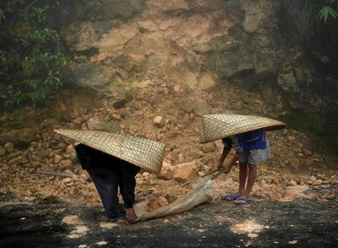

18th June 2022 (6 Topics)
Context
Meghalaya’s Mawsynram, the world’s wettest place, rewrote its June rainfall records held since 1940.
About
- The 24-hour rainfall recorded recently was a whopping 6mm, surpassing the previous record of 945.4mm of 1966.
- The second closest rainfall record was held by nearby Cherrapunji, another wet place, where the 24-hour rainfall was 972mm.
About Mawsynram:
- Mawsynram is situated in East Khasi Hill district of Meghalaya, 15 km west of Cherrapunji, Mawsynram is 1400 m above sea level.
- The ‘Maw’ in Mawsynram is a Khasi word which means ‘stone’, thus referring to certain megaliths found in the Khasi Hill area.
- The village is most famous for the gigantic formation of a stalagmite, which resembles the shape of a ‘shivling’.
- With 11,872 mm of rainfall received annually, Mawsynram beats Cherrapunji by a slender margin.
- Cherrapunji receives 11,777 mm of rainfall.
- The rains are so intense in Mawsynram that the villagers use thick grass to sound-proof their huts from the deafening rain.
- The women of Mawsynram use rain covers known as ‘knups’, using bamboo slivers, plastic sheets and broom grass to create a rain shield that resembles a turtle shell, which is then worn on the head.
- The knups are large enough to keep rain off the whole body right up to the knees.
- Meteorologists believe Mawsynram’s location plays a huge part in it receiving huge amount of rainfall.
- Moisture gathers over the Bay of Bengal, it causes precipitation over Mawsynram, leading to a heavy and very long monsoon season.
Rainfall at Mawsynram:
- Since northeast India is mostly hilly and is an extension of the Indo-Gangetic Plains, the region is highly sensitive to changes in regional and global climate.
- Pre-monsoon and monsoon are the rainy seasons of northeast India.
- Rain-bearing summer air currents (the Bay of Bengal branch of monsoons) that move north from Bangladesh’s hot and humid floodplains hit the funnel-shaped relief of the Meghalaya hills with deep valleys and gorges.
- The steep parallel mountains (Garo, Khasi and Jaintia hills) in Meghalaya block the movement of the clouds to the north
- They are squeezed in through the gorges and then forced to ascend the steep slopes and shed most of their rainfall in the region.

About knups:
- Knups are made from banana leaves lashed to a frame of bamboo.
- They are worn rather than carried, which allows you to use your hands. And if you lean into the wind, they won’t blow inside out, or away.
- Knups are the traditional umbrellas of Northeastern India, and are here being used in the wettest place on earth, Mawsynram, which has over 38 feet of rain a year.

More Articles


